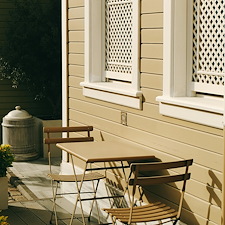Pressure Washing a Wood Deck vs a Trex Deck in Southern MD

Pressure Washing: Wood Deck vs. Trex Deck
Pressure washing is an effective way to clean and maintain outdoor decks, but the process differs significantly between traditional wood decks and composite Trex decks. Understanding the proper techniques for each material is crucial to prevent damage and extend the life of the deck.
Pressure Washing a Wood Deck
Wood decks, typically made from cedar, pine, or redwood, require careful pressure washing to avoid gouging the surface or causing splintering. Here’s how to properly pressure wash a wood deck:
1. Preparation
Remove furniture, grills, and planters from the deck.
Sweep off loose debris and leaves.
Cover nearby plants with plastic sheeting to protect them from detergent runoff.
2. Choosing the Right Pressure Washer Settings
Use a pressure washer with a PSI (pounds per square inch) between 500-1,200 to prevent damage.
Attach a 25- to 40-degree nozzle for a wide spray pattern, which reduces pressure intensity.
3. Cleaning Process
Apply a deck cleaner or a mixture of mild detergent and water. Let it sit for 10-15 minutes to loosen dirt and mildew.
Start pressure washing, keeping the wand 6-12 inches from the surface and using long, even strokes along the wood grain.
Avoid concentrating on one spot for too long, as this can etch the wood.
4. Post-Cleaning Steps
Allow the deck to dry completely (24-48 hours) before sealing or staining.
Sand rough or raised fibers caused by pressure washing to ensure a smooth finish.
Apply a protective sealer to enhance durability and weather resistance.
Pressure Washing a Trex (Composite) Deck
Trex and other composite decking materials are made from a combination of wood fibers and plastic. They are designed to be low-maintenance, but mold, mildew, and dirt can still accumulate over time. The pressure washing process for Trex decks is different from that of wood decks.
1. Preparation
Clear off furniture and debris.
Sweep or use a blower to remove loose dirt.
Rinse the deck with a garden hose to remove surface dust.
2. Choosing the Right Pressure Washer Settings
Use a pressure washer with a PSI of 1,500 or lower to avoid damaging the composite surface.
Attach a fan-tip nozzle (40-degree or wider) for gentle cleaning.
3. Cleaning Process
Apply a manufacturer-approved composite deck cleaner or a mild soap and water solution.
Let the solution sit for 10-15 minutes to break down grime.
Gently pressure wash, keeping the nozzle at least 8-12 inches from the surface.
Work in sections, using long, even strokes to prevent streaking.
4. Post-Cleaning Steps
Rinse thoroughly to remove any residue.
Allow the deck to air dry completely before placing furniture back.
Key Differences in Pressure Washing Wood vs. Trex Decks
Feature Wood Deck Trex Deck
PSI Range 500-1,200 Up to 1,500
Nozzle Type 25-40 degrees 40-degree or wider
Cleaning Solution Deck cleaner, mild soap Composite-safe cleaner, mild soap
Technique Along the wood grain Long, even strokes
Drying Time 24-48 hours Dries quickly
Final Thoughts
Proper pressure washing techniques help keep both wood and Trex decks looking their best while preventing damage. Wood decks require lower pressure and additional post-cleaning steps, like sanding and sealing, whereas Trex decks need a more delicate approach with the right cleaning solution. By following the correct process for each material, homeowners can ensure a clean and well-maintained deck for years to come.
Location: Leonardtown, MD
Project Image Gallery

